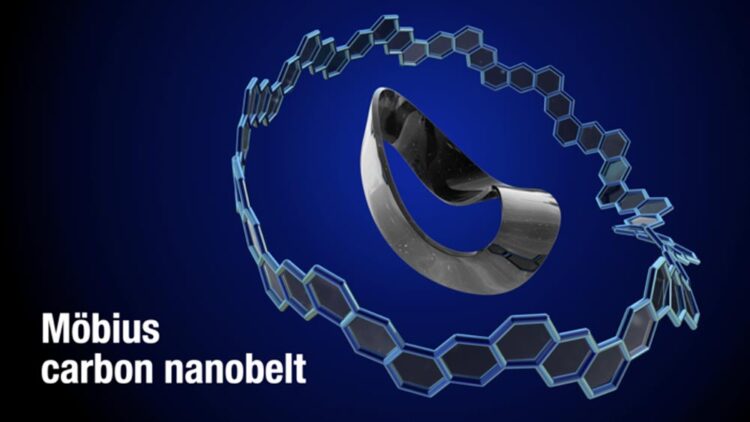A Möbius band constructed solely by carbon atoms

A new synthesis method creates a belt-shaped molecular nanocarbon with a twisted Möbius band topology, i.e., a Möbius carbon nanobelt.
Credit: Issey Takahashi
Scientists have synthesized the first belt-shaped molecular nanocarbon with a twisted Möbius band topology—a Möbius carbon nanobelt—that paves the way for the development of nanocarbon materials with complex topological structures.
Obtaining structurally uniform nanocarbons—ideally as single molecules—is a great challenge in the field of nanocarbon science in order to properly relate structure and function. Thus, the construction of structurally uniform nanocarbons is crucial for the development of functional materials in nanotechnology, electronics, optics, and biomedical applications. An important tool for achieving this goal is molecular nanocarbon science, which is a bottom-up approach toward creating nanocarbons using synthetic organic chemistry. However, the molecular nanocarbons synthesized so far have simple structures, such as that of a ring, bowl, or belt. In order to realize unexplored and theoretically predicted nanocarbons, it is necessary to develop new methodologies for synthesizing molecular nanocarbons with more complex structures.
Now, a team led by Kenichiro Itami (Professor, Nagoya University), and Yasutomo Segawa (Associate Professor, Institute for Molecular Science) and Yuh Hijikata, (Specially Appointed Associate Professor, ICReDD) has synthesized a belt-shaped molecular nanocarbon with a twisted Möbius band topology, i.e., a Möbius carbon nanobelt.
“The Möbius carbon nanobelt was a dream molecule in the scientific community after we reported the first chemical synthesis of a carbon nanobelt—an ultra-short carbon nanotube—in 2017. Just like belts we use every day, we imagined what would happen to our ‘molecular belt’ when tightened with a twist. It’s another amazingly beautiful molecule,” says Kenichiro Itami, leader of the research group. Such a twisted Möbius carbon nanobelt should manifest quite different properties and molecular motions compared to those with a normal belt topology. However, creating this twist is easier said than done. “We knew from our previous synthesis of carbon nanobelts that the strain energy is the biggest hurdle in the synthesis. Moreover, the additional twist within the belt structure makes the strain energy of the final target molecule even higher. The key to the success in the actual synthesis was our molecular design and detailed examination of the reaction conditions,” says Yasutomo Segawa, a co-leader of the project.
The rational synthetic route was determined by using the theoretical analysis of the huge strain derived from both the belt-shape and twisted molecular structure of Möbius carbon nanobelt. The Möbius carbon nanobelt was synthesized in 14 chemical reaction steps including a newly developed functionalization reaction, Z-selective Wittig reaction sequence, and strain-inducing nickel-mediated homocoupling reaction. Spectroscopic analysis and molecular dynamics simulation reveal that the twist moiety of the Möbius band moves quickly around the Möbius carbon nanobelt molecule in solution. The topological chirality originating from the Möbius structure was confirmed experimentally using chiral separation and circular dichroism spectroscopy.
Looking back in history, new forms of carbon and nanocarbons have consistently opened doors to new science and technology and have led to the discovery of extraordinary (and often unpredictable) properties, functions, and applications. The present work is a pioneering achievement that paves the way for the development of nanocarbon materials with complex topological structures and the birth of innovative materials science using Möbius topology.
Contacts:
Researchers
Professor Kenichiro Itami
Institute of Transformative Bio-Molecules (WPI-ITbM);
Graduate School of Science
Nagoya University
Tel: +81-52-788-6098
E-mail: itami[at]chem.nagoya-u.ac.jp
Associate Professor Yasutomo Segawa, Ph.D.
Institute for Molecular Science (IMS)
National Institutes of Natural Sciences
Tel: +81-564-59-5587
E-mail: segawa[at]ims.ac.jp
Specially Appointed Associate Professor Yuh Hijikata
Institute for Chemical Reaction Design and Discovery (WPI-ICReDD)
Hokkaido University
E-mail: hijikata[at]icredd.hokudai.ac.jp
Institutions
Institute of Transformative Bio-Molecules (WPI-ITbM)
Nagoya University
Tel: +81-52-789-4999
E-mail: press[at]itbm.nagoya-u.ac.jp
Public Relations Office
Nagoya University
Tel: +81-52-789-3058
E-mail: nu_research[at]adm.nagoya-u.ac.jp
Public Affairs, Research Enhancement Strategy Office
Institute for Molecular Science
National Institutes of Natural Sciences
Tel: +81-564-55-7209
E-mail: press[at]ims.ac.jp
Sohail Keegan Pinto (International Public Relations Specialist)
Public Relations Division, Department of Public Engagement
Hokkaido University
Tel: +81-11-706-2185
Email: en-press[at]general.hokudai.ac.jp
Journal: Nature Synthesis
DOI: 10.1038/s44160-022-00075-8
Article Title: Synthesis of a Möbius carbon nanobelt
Article Publication Date: 19-May-2022
Media Contacts
Kenichiro Itami
Institute of Transformative Bio-Molecules and Graduate School of Science, Nagoya University
itami@chem.nagoya-u.ac.jp
Yasutomo Segawa
Institute for Molecular Science (IMS), National Institutes of Natural Sciences
segawa@ims.ac.jp
Yuh Hijikata
Institute for Chemical Reaction Design and Discovery, Hokkaido University
hijikata@icredd.hokudai.ac.jp
Media Contact
All latest news from the category: Materials Sciences
Materials management deals with the research, development, manufacturing and processing of raw and industrial materials. Key aspects here are biological and medical issues, which play an increasingly important role in this field.
innovations-report offers in-depth articles related to the development and application of materials and the structure and properties of new materials.
Newest articles

Properties of new materials for microchips
… can now be measured well. Reseachers of Delft University of Technology demonstrated measuring performance properties of ultrathin silicon membranes. Making ever smaller and more powerful chips requires new ultrathin…

Floating solar’s potential
… to support sustainable development by addressing climate, water, and energy goals holistically. A new study published this week in Nature Energy raises the potential for floating solar photovoltaics (FPV)…

Skyrmions move at record speeds
… a step towards the computing of the future. An international research team led by scientists from the CNRS1 has discovered that the magnetic nanobubbles2 known as skyrmions can be…





















